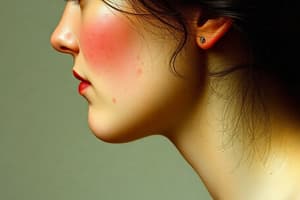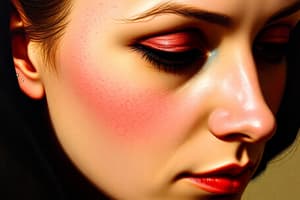Podcast
Questions and Answers
What type of mutation is associated with seborrhoeic keratosis?
What type of mutation is associated with seborrhoeic keratosis?
- Mutations in vascular endothelial growth factor (VEGF)
- Mutations in fibroblast growth factor (FGF) receptor 3 (correct)
- TP53 mutations
- Mutations in epidermal growth factor receptor (EGFR)
Which of the following correctly describes the clinical appearance of seborrhoeic keratosis?
Which of the following correctly describes the clinical appearance of seborrhoeic keratosis?
- Ulcerated lesions with surrounding erythema
- Smooth, reddish nodules that are tender
- Flat, scaly patches with varying colours
- Raised, exophytic, coin-like plaques with a 'stuck-on' appearance (correct)
What microscopic finding is NOT associated with seborrhoeic keratosis?
What microscopic finding is NOT associated with seborrhoeic keratosis?
- Significant lymphocytic infiltration (correct)
- Variable melanin pigmentation within basaloid cells
- Presence of small keratin-filled cysts (Horn cysts)
- Monotonous sheets of small cells resembling basal cells
Which of the following is a risk factor for actinic keratosis?
Which of the following is a risk factor for actinic keratosis?
How does the incidence of actinic keratosis change with age and sun exposure?
How does the incidence of actinic keratosis change with age and sun exposure?
What is the primary molecular alteration involved in actinic keratosis?
What is the primary molecular alteration involved in actinic keratosis?
Flashcards are hidden until you start studying
Study Notes
Seborrhoeic Keratosis
- Caused by mutations in fibroblast growth factor (FGF) receptor 3, activating Ras and the PI3K/AKT signaling pathways.
- Commonly observed in middle-aged or older adults.
- Characterized by round, exophytic, coin-like plaques with a "stuck-on" appearance.
- Frequently displays a color range from tan to dark brown.
Microscopic Findings
- Composed of monotonous sheets of small cells resembling normal epidermal basal cells.
- Presence of variable melanin pigmentation within these basaloid cells.
- Exhibits hyperkeratosis at the surface.
- Contains small horn cysts filled with keratin (Horn cysts).
- Features down-growth of keratin into the tumor mass, known as pseudo-horn cysts.
Actinic Keratosis
- Major risk factor is chronic exposure to sunlight.
- Pathogenesis involves TP53 mutations resulting from UV light-induced DNA damage.
- Incidence increases with age and prolonged sun exposure.
- Clinical presentation characteristics, including size, need further elaboration.
Studying That Suits You
Use AI to generate personalized quizzes and flashcards to suit your learning preferences.



